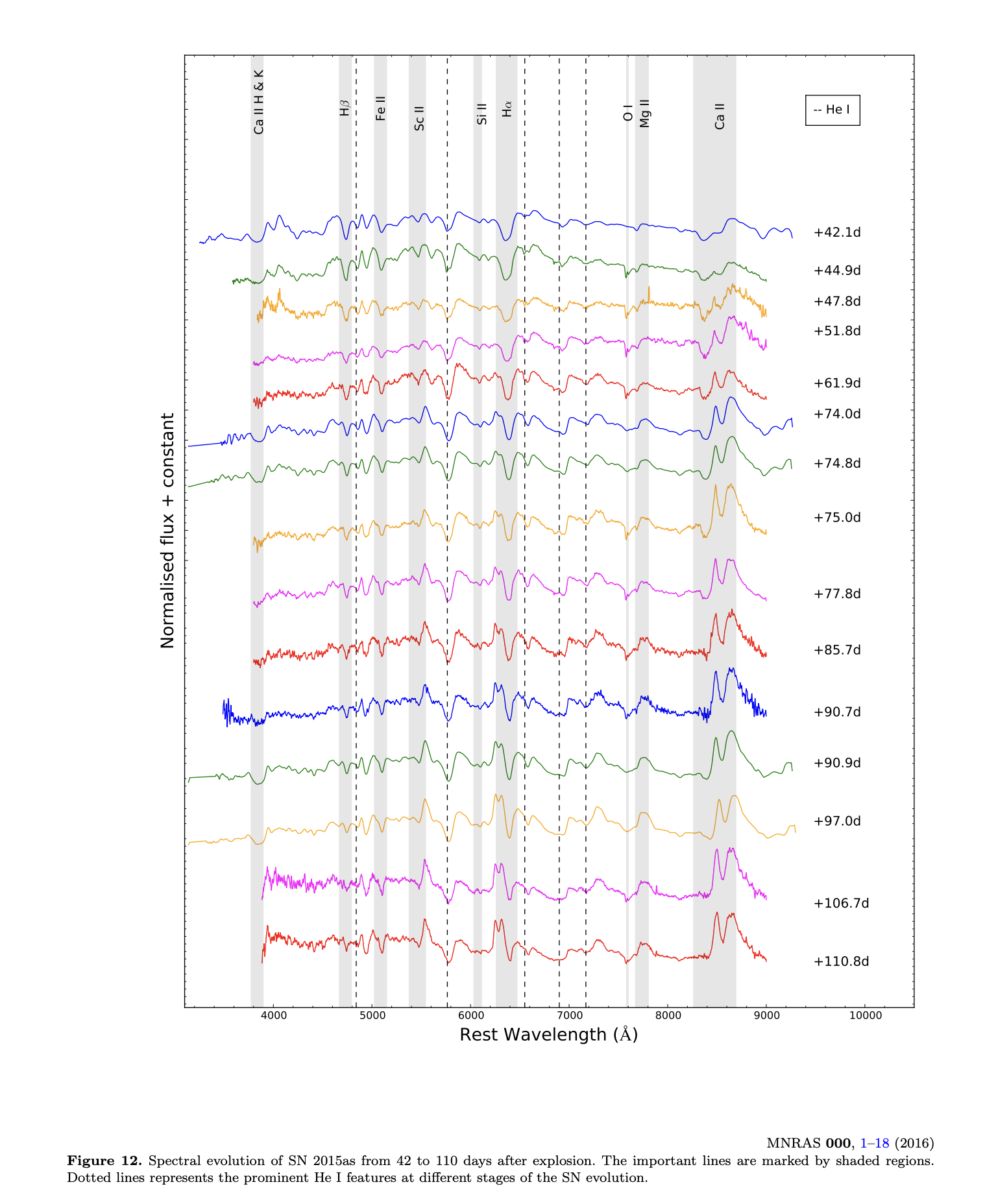Padova-Asiago Supernova Group
Highlights
SN 2015as: a low-luminosity Type IIb supernova without an early light-curve peak
Gangopadhyay, A. et al 2018, MNRAS 476, 3611 (link to pdf)
We present results of the photometric (from 3 to 509 days past explosion) and spectroscopic (up to 230 days past explosion) monitoring campaign of the He-rich Type IIb supernova (SN) 2015as. The {\it (B-V)} colour evolution of SN 2015as closely resemble those of SN 2008ax, suggesting that SN 2015as belongs to the SN IIb subgroup that does not show the early, short-duration photometric peak. The light curve of SN 2015as reaches the B-band maximum about 22 days after the explosion, at an absolute magnitude of -16.82 +/- 0.18 mag. At 75 days after the explosion, its spectrum transitions from that of a SN II to a SN Ib. P-Cygni features due to He I lines appear at around 30 days after explosion, indicating that the progenitor of SN 2015as was partially stripped. For SN~2015as, we estimate a 56Ni mass of -0.08 Msun and ejecta mass of 1.1--2.2 Msun, which are similar to the values inferred for SN 2008ax. The quasi bolometric analytical light curve modelling suggests that the progenitor of SN 2015as has a modest mass (0.1 Msun), a nearly-compact (0.05x1013 cm) H envelope on top of a dense, compact (2x1011 cm) and a more massive (1.2 Msun) He core. The analysis of the nebular phase spectra indicates that 0.44 Msun of O is ejected in the explosion. The intensity ratio of the [Ca II]/[O I] nebular lines favours either a main sequence progenitor mass of 15 Msun or a Wolf Rayet star of 20 Msun. 115
Gangopadhyay, A. et al 2018, MNRAS 476, 3611 (link to pdf)
We present results of the photometric (from 3 to 509 days past explosion) and spectroscopic (up to 230 days past explosion) monitoring campaign of the He-rich Type IIb supernova (SN) 2015as. The {\it (B-V)} colour evolution of SN 2015as closely resemble those of SN 2008ax, suggesting that SN 2015as belongs to the SN IIb subgroup that does not show the early, short-duration photometric peak. The light curve of SN 2015as reaches the B-band maximum about 22 days after the explosion, at an absolute magnitude of -16.82 +/- 0.18 mag. At 75 days after the explosion, its spectrum transitions from that of a SN II to a SN Ib. P-Cygni features due to He I lines appear at around 30 days after explosion, indicating that the progenitor of SN 2015as was partially stripped. For SN~2015as, we estimate a 56Ni mass of -0.08 Msun and ejecta mass of 1.1--2.2 Msun, which are similar to the values inferred for SN 2008ax. The quasi bolometric analytical light curve modelling suggests that the progenitor of SN 2015as has a modest mass (0.1 Msun), a nearly-compact (0.05x1013 cm) H envelope on top of a dense, compact (2x1011 cm) and a more massive (1.2 Msun) He core. The analysis of the nebular phase spectra indicates that 0.44 Msun of O is ejected in the explosion. The intensity ratio of the [Ca II]/[O I] nebular lines favours either a main sequence progenitor mass of 15 Msun or a Wolf Rayet star of 20 Msun. 115
